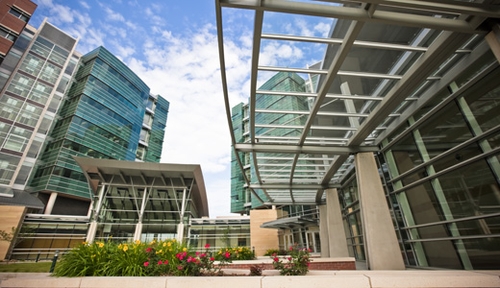UNMC researchers brought in a record total of $117.1 million in research funding for fiscal year 2017, up nearly 2 percent from $115.1 million the previous year.
“Our goal is to continue to grow our research on all fronts at a time when National Institutes of Health (NIH) funding has been fairly flat,” said Jennifer Larsen, M.D., vice chancellor for research. “Along with other funding sources, this total shows we are competitive and going in the right direction.”
Dr. Larsen has emphasized collaborative, team-based science projects and greater recruitment to clinical trials, while also expanding awareness of diverse sources of research funding and improving research processes.
As in previous years, the majority of funding – 67 percent — came from federal funding sources, predominately the NIH. Federal awards increased by nearly 6 percent while industry-sponsored grants and contracts increased 13.5 percent.
Dr. Larsen attributes the industry-sponsored growth, in part, to the work of Chris Kratochvil, M.D., associate vice chancellor for clinical research, with UNeHealth, UNMC’s contracting arm for industry-funded clinical trials, and the Clinical Research Center.
“UNeHealth has made great strides in improving processes for commercially-funded clinical trials,” Dr. Kratochvil said. UNeHealth has negotiated 83 percent of its confidentiality disclosure agreements in under two weeks, with nearly two-thirds of its clinical trial contracts negotiated in under a month. That has enabled UNMC to become more competitive among industry-funded clinical trials, he said.
Several units saw an increase in research awards: The UNMC College of Allied Health Professions increased by 39 percent, the College of Public Health by 13.8 percent, the Eppley Cancer Institute by 10 percent, the College of Pharmacy by 2.8 percent, and the College of Medicine, which has the largest portfolio, by 1.6 percent.
Dr. Larsen said a number of other factors also contributed to the increase in research funding. These included more large-grant programs; more NIH RO1 grants, which are often deemed the ‘bread and butter’ grants; more individual training awards; increased clinical trials; more Department of Defense grants including those with the National Security Research Institute; and research grant successes across the colleges.
“We want to diversify our portfolio and we’re doing that,” Dr. Larsen said.

Congrats to all our researchers for setting this record. What a great accomplishment at a time NIH funding is flat.